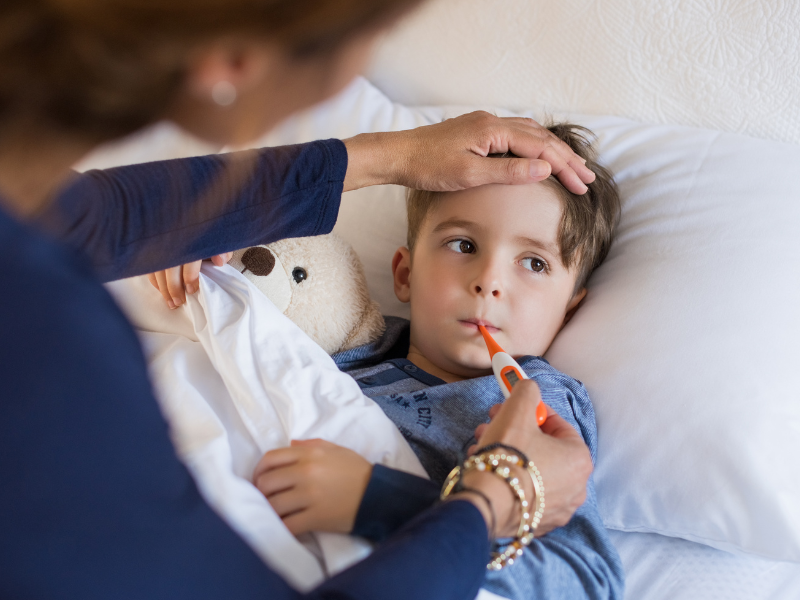Flu FAQs for Parents

Flu season is here, and if you’re a parent, you know how quickly it can turn your home into a germ war zone. We’ve seen an uptick in flu cases recently at Urgent Care of Fairhope, and our parents come armed with questions and insights that can help you navigate your child’s next case with ease. From sniffles and fevers to mysterious leg pains and rare complications, we’re answering some of the most common (and surprising) questions parents have about the flu.
How did my child catch the flu?
The flu is a respiratory infection caused by two common types of Influenza viruses. These viruses are extremely contagious and spread easily from one person to another by coughing, sneezing, or touching a shared surface. The flu spreads quickly in schools, fitness centers, and other high-traffic areas.
People with the flu are most contagious during the first three days of their illness. Symptoms usually begin one to four days after exposure to the virus.
What are the different types of flu, and does it matter which one my child has?
There are four types of flu viruses (A, B, C, and D), but types A and B are the ones that cause seasonal epidemics in humans. Treatment is the same regardless of flu type, but your doctor may test the specific type to help track local outbreaks and support future vaccine development.
While both types can make your child equally sick:
- Type A tends to cause more severe symptoms and spreads more easily. It is more common in adults and tends to show up earlier in the annual flu season.
- Type B often hits children harder than adults, particularly in children under 5 years old. It usually begins to spread later in the flu season.
Influenza C is not seasonal and typically causes mild cold-like symptoms. Influenza D only affects cattle and is not of concern to humans.
What’s the difference between a cold and the flu?
A cold and the flu are both respiratory illnesses caused by a virus. However, they are caused by different types of viruses and present with different onset and symptoms. While colds typically develop gradually, the flu hits like a truck. Your child might be playing normally one day and wake up the next with severe symptoms including high fever, body aches, extreme fatigue and headache. Cold symptoms are usually milder and centered around the nose and throat.
What are the most common flu symptoms in children?
The flu often starts suddenly and includes:
- High fever (101°F or higher)
- Chills
- Sore throat
- Cough
- Body aches
- Runny or stuffy nose
- Fatigue
- Headache
- Vomiting or diarrhea (more common in children than adults)
What are some unusual flu symptoms parents might not expect?
Beyond the classic symptoms, children can experience:
- Severe muscle aches
- Dehydration
- Stomach symptoms (more common in children than adults)
- Extreme fatigue that seems out of character
- Behavioral changes like irritability or drowsiness
My child is complaining about leg pain. Could this be related to the flu?
Yes! Flu-related leg pain and muscle aches can be intense, sometimes making it hard for kids to walk. This is due to viral myositis, a temporary inflammation of the muscles. If your child refuses to walk, has severe pain, or their urine appears dark, contact a doctor immediately.
Should I be worried about flu complications?
Most children recover from the flu without complications, but in rare cases, the flu can lead to serious issues, including:
- Pneumonia – A secondary infection that can make breathing difficult.
- Viral Myositis – A rare flu complication in children that causes muscle inflammation and weakness, which often presents as severe leg pain (particularly in the calves), difficulty walking and joint pain.
- Rhabdomyolysis – A severe muscle breakdown that can cause kidney damage (signs include severe muscle pain, weakness, and dark urine).
- Encephalitis – A dangerous inflammation of the brain causing confusion, seizures, or trouble waking up.
- Sepsis – A life-threatening response to infection that requires emergency care.
If your child has difficulty breathing, severe muscle pain, confusion, or is not waking up normally, seek emergency medical attention.
What’s the best way to treat my child’s flu?
As a viral infection, there is no cure for the flu; it has to “run its course”. Most cases can be treated easily at home by focusing on supportive care:
- Rest (lots of it)
- Fluids (water, electrolyte drinks, broth)
- Over-the-counter fever reducers (follow age-appropriate dosing)
- Light, easily digestible foods when hungry
Should I try to break my child’s fever?
Fever is the body’s natural defense against infection, so you don’t always need to lower it right away. However, if your child is uncomfortable, in pain, or has a fever over 102°F, you can use:
- Acetaminophen (Tylenol) or ibuprofen (Motrin/Advil) (never give aspirin to kids!).
- Cool compresses and light clothing to prevent overheating.
- Hydration – Encourage water, electrolyte drinks, or clear broth to prevent dehydration.
Focus on keeping them comfortable rather than hitting a specific temperature number.
When should I see a doctor if my child has the flu?
Visit a medical professional if your child:
- Has a fever above 104°F
- Shows signs of dehydration
- Has difficulty breathing
- Experiences severe muscle pain
- Has symptoms that improve but then return with fever and worse cough
For medical emergencies, always call 911 or visit the nearest emergency room.
Can my child go to school with the flu?
No. The flu is an extremely contagious infection that will spread quickly to classmates and teachers. Keep your child home until:
- They’ve been fever-free for 24 hours without fever-reducing medication
- They have enough energy to participate in class
- Most symptoms have improved
This usually means 5-7 days from symptom onset.
Can I prevent my child from getting the flu?
While no method is 100% effective, you can:
- Get yearly flu shots for the whole family
- Teach proper hand washing
- Encourage healthy sleep habits
- Maintain good nutrition
- Keep your child home when sick to protect others
What about antiviral medications?
Tamiflu (oseltamivir) can shorten flu symptoms by about a day if taken within the first 48 hours. However, it can also cause side effects in children like nausea, vomiting, and nightmares. Antivirals may be recommended if your child is at high risk (asthma, diabetes, weakened immune system).
Contact us promptly if you think your child needs antiviral treatment.
Can I bring my child to Urgent Care of Fairhope for the flu?
Absolutely! We’re here to help with flu testing, treatment, and symptom relief. Walk in—we make sure your family gets the care they need, quickly and conveniently. You can even check our waitlist online before you arrive to see how long our current patients are waiting to be seen!
Flu season can be rough, but having the right information makes all the difference. Share this guide with fellow parents, and let’s keep our kids healthy this flu season!
Search our Blog
Recent Posts
Festive Holiday Treats for Diabetic Kids
The holidays are filled with cookie swaps, candy canes, and dessert tables as far as the eye can see. But for parents and teachers of diabetic children, the season can be a balancing act. Thankfully, [...]
Urgent Care of Fairhope Named One of the Best Urgent Care Clinics in Alabama
When you need medical care fast, you want to know you're choosing a provider you can trust. Recently, our community made that choice clear: Urgent Care of Fairhope was named a 2025 Best of [...]
Jingle Bells on The Bay: Fairhope Holiday Festivities 2025
Ho-ho-hold your reindeer! As we deck the halls and jingle all the way down the pier, get ready to unwrap a festive season like no other. Right here on the Eastern Shore, we’re mixing Southern [...]
Are Sugar Rushes Real? What Parents Need to Know
It’s a familiar scene for parents everywhere: the birthday cake gets sliced, the candy wrappers start flying, and within minutes the room erupts into chaos as kids start bouncing off the walls. Cue the collective [...]
World Menopause Month: What Women Need to Know
Menopause is a fact of life for all women, but it’s far from one-size-fits-all. Some women experience it earlier or later than others, symptoms can range from barely noticeable to highly disruptive, and individual health [...]
Fairhope’s Spook-tacular Guide to Halloween Happenings 2025
Boo-tiful Fairhope and Eastern Shore residents, gather ’round for a spine-tingling treat! It’s that time of year when things go bump in the night, and Urgent Care of Fairhope is here to ensure you don’t [...]


